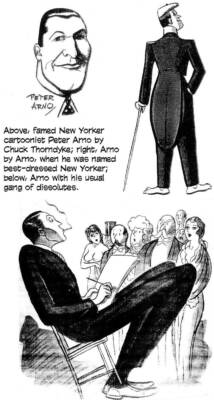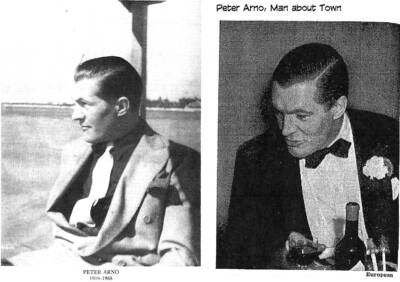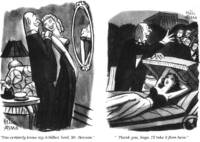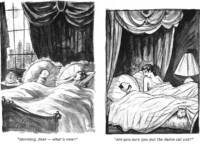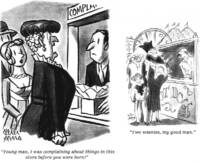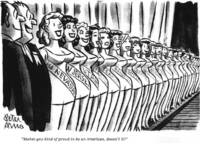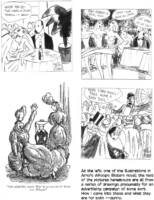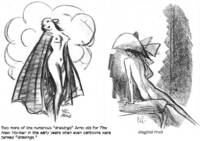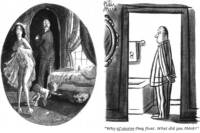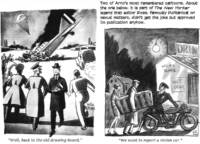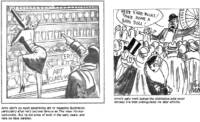The Roaring Twenties and the Essence of The New Yorker: Funnies Farrago Meets Peter Arno.
THE DECADE THAT HAS ENTERED AMERICAN MYTHOLOGY as “the roaring twenties” was created, it is sometimes alleged, by F. Scott Fitzgerald, a novelist, and John Held, Jr., a cartoonist. Gratifying as it may be to partisans of the literary and graphic arts to fancy that the social temper of a distinctive period of U.S. history could be brought into being through the power of the pen, life did not really imitate art any more readily in the twenties than it does now.
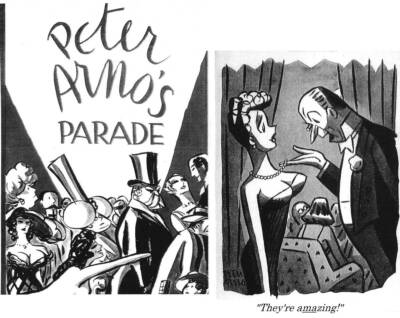 It’s true that Fitzgerald’s 1920 novel, This Side of Paradise, captured the spirit of disillusioned ennui and impertinent disregard for convention that infected the joy-riding Younger Generation in post-World War I America. And it’s true that Held’s drawings of spindle-shanked flappers and bell-bottomed sheiks of a few years later became the iconography of what Fitzgerald had christened the Jazz Age. But another cartoonist, Peter Arno, reflected the spirit of the age, too, in both life and art — although perhaps more that worn and dissipated sensation that collects at 3 a.m. at the end of a party than the boisterousness that infects the proceedings early in the evening.
It’s true that Fitzgerald’s 1920 novel, This Side of Paradise, captured the spirit of disillusioned ennui and impertinent disregard for convention that infected the joy-riding Younger Generation in post-World War I America. And it’s true that Held’s drawings of spindle-shanked flappers and bell-bottomed sheiks of a few years later became the iconography of what Fitzgerald had christened the Jazz Age. But another cartoonist, Peter Arno, reflected the spirit of the age, too, in both life and art — although perhaps more that worn and dissipated sensation that collects at 3 a.m. at the end of a party than the boisterousness that infects the proceedings early in the evening.
The 1920s, however, did not roar because of the ministrations of either novelist or cartoonist. In the beginning, in fact, it wasn’t a roar at all that distinguished the period: it was a hum.
A quiet hum at first — quiet but persistent. A hum that grew in volume until it became a steady drone and then, finally, a thunderous rumble. It was the sound of business enterprise, of manufacturing and commerce. It was the sound of twentieth century America — an age of mass production, mass consumption, standardization, national advertising, consumer economics, business enterprise, and mass communications and entertainment.
The twenties in America roared with the exuberance of a nation shaking off the fetters of the Victorian era, it roared with the defiance of the Young rebelling against the conventions of out-outmoded mores, it roared with the outrage of the Older Generation at the audacious behavior of their offspring, it roared with the sound of cash registers ringing up sales in celebration of the country’s unprecedented prosperity. By 1925 when Peter Arno began his career as a cartoonist in earnest, the roar was deafening.
The din of the endless all-night party the country seemed embarked on was orchestrated by the flapper and the bootlegger, and it was augmented by bathtub gin and other brands of illegal booze, by high-speed cars and hit men, by the screaming headlines of tabloid newspapers that announced the fads and follies of the moment to the waiting world, by frenzied speculation on Wall Street, even by short skirts and bobbed hair and hip-flasks. Contributing to this outlandish cacophony was the clash of licentiousness and repression, of scientific thought and religious fundamentalism, of self-indulgent Freudian theory and self-righteous blue laws.
Prohibition, the Anti-Saloon League’s hope for national sainthood, was well on its way to becoming a colossal failure. By 1923, the year Arno abandoned a college education in favor of a bohemian artistic life in Greenwich Village, the supply of illicit liquor was coming into the country in a torrent — across the Canadian border, from ships lying offshore just beyond the 3-mile limit (in “Rum Row”). Instead of being sainted, the nation was besotted.
Breaking liquor laws was commonplace. And almost universally condoned. Edward S. Martin, writing in the nation’s venerable humor magazine Life, reminded his readers that lawbreakers historically were often heroes: “Among the people who did most for human liberty and human happiness is a splendid gallery of lawbreakers.”
Speakeasies were as much a part of urban life as the growing problem of streets congested by automobile traffic. Speaks were different than saloons: since admittance tended to be restricted to those who knew the password ( “Joe sent me”), a secretive clubby membership atmosphere prevailed. Hence, these establishments of the evening’s entertainment became “night clubs.” (And the admission fee charged to help maintain the hideaway was called, logically, a couvert charge.) Each night club tended to develop its own unique ambiance.
A one-time movie actress named Texas Guinan made a career as a hostess enlivening a succession of New York’s night spots: “Never give a sucker an even break,” she advised. And she greeted her customers accordingly: “Hello, sucker,” she’d bellow from across the room. For a less boisterous evening, the crowds gathered at Helen Morgan’s where the bad booze was made palatable by the torch singer’s husky contralto. (Illustrator James Montgomery Flagg explained her appeal best: she was, he said, the composite of all the ruined women in the world.)
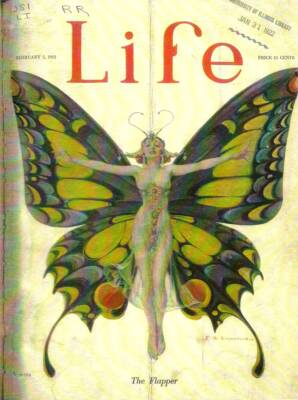 But if there is any single image that epitomizes the era it is not the funereal Mr. Dry in political cartoons; it is that effervescent bundle of giddy self-assurance, girlish laughter, and unabashed sex appeal — the flapper. The visual symbol of the flapper did not appear widely until she was an accepted type — that is, until about 1923; but she had become a familiar social phenomenon long before then. The typical flapper was a nice girl who was a little fast ( “brazen and at least capable of sin if not actually guilty of it,” as Shelly Armitage says in her biography of John Held, Jr.).
But if there is any single image that epitomizes the era it is not the funereal Mr. Dry in political cartoons; it is that effervescent bundle of giddy self-assurance, girlish laughter, and unabashed sex appeal — the flapper. The visual symbol of the flapper did not appear widely until she was an accepted type — that is, until about 1923; but she had become a familiar social phenomenon long before then. The typical flapper was a nice girl who was a little fast ( “brazen and at least capable of sin if not actually guilty of it,” as Shelly Armitage says in her biography of John Held, Jr.).
The flapper offended the Older Generation because she defied accepted conventions of decorous feminine behavior. Women’s hair had always been long; the flapper wore hers short — “bobbed.” She used make-up (which she often applied in public). She wore tight, short dresses which bared her arms and her legs from the knees down; underneath, she wore as little as possible. And on the beach, she resorted to a skin-tight, single-piece costume that didn’t cover arms or legs and that therefore left very little of her figure to be imagined.
But she did more than symbolize the revolution in feminine fashion and mores: she also embodied the spirit of the times in a way no other figure did. Held did more to create this revolutionary icon than anyone else. But Peter Arno, as I said, personified the Age of Flaming Youth in his life in those days, and his art for The New Yorker incorporated its giddy infatuations as surely as Held’s did albeit somewhat more somberly (if we can apply that word to cartooning).
The revolution in manners and morals that characterized the decade was more than a simple insurrection: it had escalated into a way of life for a substantial portion of the population, particularly the Younger Generation. To a generation of parents, the behavior of American youth was scandalous, but by mid-decade, the Young had thoroughly corrupted their elders: fathers and mothers had begun aping their sons and daughters. F. Scott Fitzgerald analyzed the phenomenon:
“The sequel was like a children’s party taken over by the [grown-ups], leaving the children puzzled and rather neglected and rather taken aback. Their elders, tired of watching the carnival with ill-concealed envy, had discovered that young liquor will take the place of young blood, and with a whoop the orgy began. The younger generation was starred no longer.”
The Age of Flaming Youth had dawned and bathed the entire country in its glow, and so the nation became the Land of the Young — with Edna St. Vincent Millay its poet laureate: “My candle burns at both ends; / It will not last the night; / But, ah, my foes, and oh, my friends, / It gives a lovely light.”
And Peter Arno — musician, artist, party animal — was in exactly the right place to be drawn to the flame like a moth.
Arno’s cartoons embodied the sophistication and irreverence of The New Yorker, and they appeared in the magazine almost from the very beginning. But Arno’s beginning scarcely suggested he would become one of the nation’s celebrated cartoonists. He was born Curtis Arnoux Peters, Jr., on January 8, 1904 in New York City, son of a New York Supreme Court justice and Edith Theresa Haynes.
As scion of a prominent family, Curt (as he was called then) was sent to Hotchkiss School in Lakeville, Connecticut, and then to Yale College, where he indulged his interest in music and art instead of pursuing the career as a banker or lawyer that his father planned for him. He drew cartoons for The Yale Record and painted pictures on the walls of local restaurants and cafes. (For a long time — into the 1940s and perhaps even now — a New Haven eatery called the Bulldog Grille featured an early Arno mural signed Curtis Arnoux Peters that ridiculed the gridiron heroes who give their all for Alma Mater.) And he plunged enthusiastically into the recreations of the day.
In his spare time (which might have been most of the time), Curt formed a nine-piece band called the Yale Collegians, playing piano, banjo, and accordion himself as needed. With a young unknown named Rudy Vallee as lead singer, the group was engaged by Gilda Gray’s Rendezvous, one of Manhattan’s first post-war nightclubs, where the nightly attraction was Gilda’s performing a sensational shimmy dance.
Quickly succumbing to the taste of the era for night life, Curt was virtually a prototype of the Jazz Age’s young man about town: rich with a breezy debonair demeanor, he was tall, urbane, impeccably dressed and multi-talented, and he had the jutting-jaw good looks of a model in the popular Arrow shirt ads of the day. And the lure of the nightlife of the City proved too powerful to resist.
In 1923, he left Yale and the pursuit of a degree, joined the artists’ milieu in the Village, and changed his name to Peter Arno in order to separate his identity from his father’s (that is, to avoid embarrassing the old man). He wrote music (achieving modest Tin Pan Alley success with a song called “My Heart Is on My Sleeve”), played in his band, painted more murals in bistros and cafes, and submitted drawings, without selling many, to the humor magazines, Judge and Life. He was about to abandon his ambition to be an artist for a musical career with a band in Chicago when he received a check for a drawing that he had submitted to a new humor magazine that had debuted February 21, 1925.
With the publication of this spot illustration in the June 20, 1925, issue of The New Yorker, Arno began a forty-three year association with Harold Ross’s journal, his single-panel cartoons helping hugely to shape the magazine’s sophisticated but irreverent personality. (The illustration is reproduced at the end of this essay.)
Arno’s first success in the magazine was with a series of cartoons about two tipsy middle-aged harridans who were probably charwomen on their night off, which they spent cavorting about town in feathered hats, long formal gowns and muffs, punctuating their incongruously earthy observations of life around them with spirited cries of “Whoops!” Here the old girls are strolling down the street in the rain and talking as they go:
“The hussy,” says one, “ — she says ‘I’ll give yuh a ring’ — then she asks me, ‘Is yer phone number under yer own name?’ Lordy!”
“Whoops!” says the other. “Wha’ did she think it was under — yer bust measure?”
Or, as they both sit, exhausted, on a curb, and one of them, having removed her shoes for the moment, says: “Whoops!”
”What’s up, dearie?” asks the other.
“Oh, nuthin’ — only it’s kinda nice t’ get yer boots off fer a minute now that th’ fleet’s gone — Gor!”
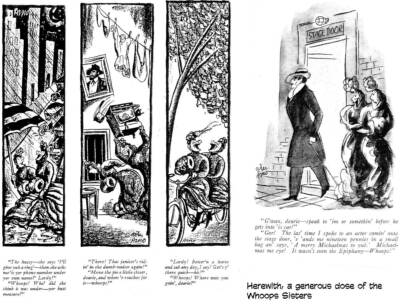 Or (yet again) they stand behind a nude statue in a museum and, peering around for a front view, exclaim: “Whoops! It’s a girl!”
Or (yet again) they stand behind a nude statue in a museum and, peering around for a front view, exclaim: “Whoops! It’s a girl!”
Christened the Whoops Sisters, this bibulous pair of dowdy rowdies appeared three times a month for three years and stimulated newsstand sales of the magazine. But it was with his next creations that Arno contributed a vital essence to the character of The New Yorker.
The first of these was an aristocratically mustached old gent in white tie and tails, whose eyes, as Somerset Maugham observed, “gleamed with concupiscence when they fell upon the grapefruit breasts of the blonde and blue-eyed cuties” whom he avidly pursued.
These same voluptuous damsels kept company with another regular member of Arno’s ensemble — a thin, bald albeit youngish man with a wispy walrus mustache, a razor sharp nose, and an ethereally placid expression who was often seen simply lying in bed beside an empty-headed ingenue with an overflowing nightgown. The other regular was a ponderous dowager, stern of visage and impressive of chest, whose imposing presence proclaimed her right to rule.
This trio was joined by an assortment of rich predatory satyrs in top hats, crones, precocious moppets (one of whom was forever chancing upon his shapely aunt when she was naked), tycoons, curmudgeonly clubmen, fuddy-duddies and barflies of all description — in short, the probable population of all of New York’s cafe society.
This Manhattan menagerie Arno subjected to merciless scrutiny from his favored position well within the pale, and he found something ridiculous and therefore valuable in everyone from roue to cab driver. Arno’s cartoons juxtaposed the seeming urbanity of his cast against their underlying earthiness, thereby stripping all pretension away. He proved again and again that humankind is just a little larcenous and lecherous and trivial in its passions and pursuits, social decorum to the contrary notwithstanding.
Ross, although a fairly uncouth appearing and profusely profane bantering editor, was passionately opposed to sexual innuendo. He particularly hated Arno’s depiction of “tits,” Arno once reported. “But endured my repeated emphasis on the mammary glands of women with weary and tolerant resignation. He’d behold a drawing of mine, featuring a busty young lady or two, and the reaction would usually be: ‘Goddammit Arno! Look at those goddamn tits again!’”
Produced a generation before Hugh Hefner’s Playboy, Arno’s voluptuous beauties and their sex lives were a sensation for their time. But Arno’s contribution to the history of cartooning was more profound and lasting than the way he drew the female chest.
JAMES GERAGHTY, who eventually rose to the August position of art editor at The New Yorker, once remarked that Arno did not adapt to the character of the magazine: rather, he was one of the most important factors in forming that character. Arno also looms large in the emergence of the modern, single-panel magazine gag cartoon.
Arno was often credited with inventing the single-speaker cartoon at The New Yorker, but he specifically denied it (in his introduction to Peter Arno’s Ladies and Gentlemen).
“I like to think that I did,” Arno wrote, “and I have been given credit for it; but nothing so basically simple could be ‘invented.’ It must be as old as Confucius, or older. It was just lying there all the time, waiting to be picked up. I gravitated toward it naturally, and was one of the first to use it consistently, so that it became more or less a trade-mark. … I suppose it appealed to me because my English grandfather, who was the light of my boyhood years, had taught me that brevity was the soul of wit . … As with a smoking-room story, the shortest caption, if it hits with a wallop, brings the loudest guffaw, the kind that warms my heart.”
Other cartoonists were doing the so-called “one-line caption” cartoons long before The New Yorker debuted. But not as a matter of routine — just occasionally. Now and then. The usual form of the magazine cartoon was the illustrated comic dialogue, in which the humor resided entirely in the verbal exchange between several speakers that was printed beneath a picture like a script for a play. Arno describes the circumstance that prevailed until the mid-twenties and how The New Yorker contributed to changing it:
“In the days of the old Life, Puck, and Judge, many an artist drew endless variations of his particular speciality — boy-and-girl, old-gentleman-and-small-boy, monkey-talking-to-giraffe — and then some bedeviled staffer would sit down and tack on whatever variation of stock joke, pun , or he-and-she dialogue he could think of. … Harold Ross in starting The New Yorker cast out the stale joke, the pun, the he-and-she formula; and before long, these faithful old servants were dying everywhere else. … In their place there developed a humor … based upon carefully thought-out, integrated situations with picture and caption interdependent.
“This interdependence was the most important element of such cartoons. The reader had to examine the picture before the joker in the caption made its point, or vice versa. The quick revelation of incongruity (actually, the sudden realization by the reader that he’d been hoodwinked) brought the laugh. Or at least we hoped it would.”
Ross did not invent the single-speaker caption cartoon any more than Arno did. But Ross had a good feel for the superiority of the humor in that form. And he insisted his cartoonists work to achieve the effect Arno describes here. At The New Yorker, the single-speaker caption cartoon became, eventually, the preferred mode. And thus Ross’s magazine established the form as the most effective for the single panel cartoon. And Arno, as one of the most spectacular practitioners of the form in its earliest manifestations, acquired the reputation of having invented it.
Arno says he thought up his own gags in the early years. “I had to,” he wrote. “I was developing a style and a new kind of format, and there was no way anyone else could do it for me. But as time went on and a distinct pattern for my work was set, it became easier for others to make contributions.”
The same was doubtless true with other cartoonists whose style of humor was distinctive. Even, apparently, as individual a talent as George Price, who, I was startled to learn in Lee Lorenz’s Art of the New Yorker, produced only one of his hundreds of highly idiosyncratic New Yorker cartoons from his own idea. In his account of life at The New Yorker, James Thurber says some cartoonists thought up their own ideas; others used the ideas supplied by staff writers.
“In the early years,” Thurber wrote, “Andy [E.B.] White and I sent [in] scores of captions and ideas, some of them for full-page drawings, others for double-page panels for Gluyas Williams and Rea Irvin. If a caption didn’t suit Ross — and he was as finicky about some of them as a woman trying on Easter bonnets — it was given to White to ‘tinker.’ [Wolcott] Gibbs and I did tinkering, too, but White was the chief tinkerer.”
Lorenz agrees that White may be the most influential of the magazine’s writers in shaping and refining gag cartooning. “Polishing captions” was one of White’s first assignments upon joining the magazine’s staff. Brendan Gill in Here at The New Yorker also discusses White’s contribution to the magazine’s cartoons: “It was crucial that these captions be as succinct and colloquial as possible, and White had a fine ear for the natural rhythms of American speech. His seemingly effortless tinkerings brought thousands of drawings back from the brink of rejection.”
Elsewhere, in a discussion of Arno’s development as a cartoonist, Lorenz credits Philip Wylie with creating Arno’s gags.
Arno said that he submitted rough charcoal sketches of his ideas, and these were reviewed by the weekly “art meeting” at The New Yorker. “The ones that seem funny and solid enough are picked out for finishing, often with constructive suggestions for improving the picture or rewording the caption,” he explained. He then executed the final drawing — a “painful” experience, according to Arno, about which we will hear more anon.
Thomas Kunkel in his biography of Ross, Genius in Disguise, tells the story of an idea generating session between Arno and one-time art editor Albert Hubbell. Hubbell went to Arno’s Park Avenue apartment one afternoon where he found Arno, “a creature of the night,” still in a silk dressing gown. Arno fixed himself a hamburger and sat down to hear Hubbell’s ideas.
“One that Hubbell liked and pitched hard involved a billiard table,” Kunkel writes. “But in no time, Arno was frowning. It turned out that Ross paid him a substantial bonus for full-page cartoons, which presupposed vertical concepts, so a billiard table was altogether too lateral to even consider. ‘Wait a minute, Hubb, wait a minute,’ Arno said, ‘ — let’s go for those pages.’”
Arno was an admirer of Honore Daumier and Georges Rouault, and his earliest drawings with their simple outlines and grease-crayon shading show the influence of the former, but before long, the Rouault line began to assert itself. Eventually, Arno employed a broad brush stroke to delineate his subject with the fewest lines possible, holding the compositions together with a wash of varying gray tones.
“Each drawing is a painful tooth-pulling experience,” he wrote, “because I insist on including characterization, form, design, chiaroscuro, etc. — that the reader takes for granted.”
Despite the raw simplicity of his style, Arno researched for his cartoons. Jud Hurd (editor of the venerable Cartoonist PROfiles), reported on a visit he made to Arno’s studio: “I was amazed to find his drawing board piled high with candid photos and sketches made at various restaurants, nightspots, etc., around New York. It was then I realized how painstaking he was with his cartoons. I’ll always remember a photo he’d snapped at some club — showing a couple dancing in a unique and comical attitude — a pose that a cartoonist would never think of unless he’d seen it in real life.”
The cartoonist, however, usually pooh-poohed the artistry in his cartoons. He once said: “My art studies have been principally pursued in dark alleys.”
But he worked hard to give his drawings the look of spontaneity. “It must be done rapidly, with careless care,” he once wrote, “so it doesn’t look like work. It must look fast and loose, with a drawn-on-the-spot quality.” But, he confessed, “I’ve never been able to achieve in cartoons the artistic level (in spontaneous dash and freedom and draftsmanship) that I have in drawings and paintings for my own pleasure.”
While working, Arno frequently assumed the expressions of the faces he was drawing, lost in the intensity of his concentration. A dedicated craftsman, he customarily rendered a single cartoon scores of times until the combination of artful design and accidental execution felt right. Penciling in the layout, he dawbed at the artwork as often with his eraser as with his pencil. Once he even complained that he used more erasers than all other artists in The New Yorker combined.
Just as he drew quickly, Arno moved quickly, talked rapidly, and ate fast. And he drove as fast as the law permitted. Once he sued an automobile manufacturer because the car he bought would not do 155 mph as advertised.
ARNO INDULGED HIS INTEREST in music as well as art throughout his life. In 1931, he co-authored a Broadway musical satire called “Here Comes the Bride.” It opened in October but didn’t do much else. Percy Hammond, a reviewer, wrote: “Peter Arno in a magazine is from the Mayfair, but in a musical comedy he is from the sticks.” But Arno celebrated the opening anyway. Renting a suite at the Waldorf-Astoria, he threw a party that ran up a bill of $1,215.80, a amount he took over three years to pay off and then only when the hotel sued him for the balance of $782.15.
During the thirties, he designed sets for Paramount and Twentieth Century Fox. He dabbled in various businesses — sports car manufacturing, producing, writing, composing for the theater. Bands. And he painted.
His art was displayed in exhibitions several times in New York galleries. Of the show at the Marie Harriman Gallery in 1938, Lewis Mumford wrote in The New Yorker: “There is nobody drawing in America that I can think of, except possibly Noguchi, who has shown anything like Arno’s skill in sweeping a simple wash across a figure to create life and vehemence in the whole pattern after he has outlined its parts; and no one has dramatized so effectively the elementary battle of black and white, in a fashion that makes a face leap out of the picture like a jack-in-the-box, knocking one in the eye at the same time that the idea of the joke enters one’s mind. His intention is as unflagging as his wicked commentaries, though they both spring out of certain well-defined areas of metropolitan life, half-real, half-fantastic, altogether wild and unembarrassed and exuberant.”
Even Arno’s famous signature attracted the attention of critics. Henry McBride of the New York Sun wrote: “What a super creation that signature is! It’s a complete thing in itself, like a coin; or like one of those crashing chords of Handel that Samuel Butler admired so much; and when the artist smacks it to the drawing up in the skies, as he does sometimes, it’s so very Handelian that I just bow down and worship.”
Composer, painter, entrepreneur — and all the while, Arno kept on doing cartoons in all-night bouts for The New Yorker. Although he occasionally took lucrative advertising assignments, he generally avoided them because the advertisers normally didn’t give him the freedom he desired. “None of them — clients or agencies,” he wrote, “understand that to get the value of a creative artist is to let him do it his own way. The general attempt is to hedge him in with inappropriate format, excessive copy, trademarks, inserts, etc.”
Only once, Arno reported, had he enjoyed the freedom he craved with an advertising assignment — and that was with Pepsi-Cola.
Arno devised a leisurely way of life: he worked only about two days a week, making rough sketches of cartoon ideas and sending them in to The New Yorker. He produced the final drawings in batches, several at a sitting, working twenty-four or thirty-six hours at a stretch. Sometimes he grew worn with the expenditure of nervous energy his method required, and he would take several months or a year off to travel — to Mexico, Nassau, Europe, Hollywood, and the ghost towns of the American West.
“I’ve never sought great riches,” Arno wrote, “particularly in later years — but have been satisfied with comfortable affluence — while I pursued life and work in a way that was independent, satisfying, and deeply rewarding. My goal since the beginning was to have mornings (and days) free, sleep as late as I wanted, enjoy leisurely breakfast [and] several hours to digest papers and newspapers, devour the Times. I think I’ve come as close as possible to a free, untrammeled life without inheriting ten million. I’ve done my work in concentrated, intense periods — considered work as a means toward the enjoyment of life — not center of existence — as well as a fulfillment of living.”
Well-known as a bon vivant for the first decade of his fame, Arno pursued women and was caught twice. On August 12, 1927, Arno married Lois Long, who wrote for The New Yorker under the pen name Lipstick; they had a daughter and then divorced by Reno decree on June 29, 1931. Arno’s second wife was a glamorous debutante named Mary “Timmie” Livingston Lansing whom he married in August 1935 and divorced in July 1939.
Arno’s social life was enthusiastically chronicled in the gossip columns, and when, between marriages, he paid too much attention to Mrs. Cornelius Vanderbilt, Jr., the resulting altercation with her husband produced reams of newspaper copy for days. Vanderbilt chanced upon Arno at a railway station in Reno and lunged at him. Arno slipped and fell, and before he could regain his footing, Vanderbilt had been restrained. The fracas never amounted to more than the merest hostile encounter, but the tabloid press and society reporters had a field day with it, embellishing it endlessly in the manner of present-day pundits chewing over the latest Clinton would-be scandal.
Mademoiselle magazine once dwelled on Arno’s fashionable appeal: “Your first impression of him is all tans: tan hair, a tan complexion, hazelish eyes, small ears set close to a massive head, a tan tweed jacket, tan flannel trousers, white shoes, and a fetching bit of bare ankle showing above them.”
Even as late as 1941, he was the object of societal admiration: he was voted the best-dressed man in America by the Custom Tailors Guild. Arno’s sartorial splendor was then promptly dwelt upon by the newspaper PM: “Arno, who’s been dressing himself for thirty-two of his thirty-seven years, took his election in his stride. His six-foot-two-inch 190-pound physique may have helped a little. Arno estimates he spends only $1,500 a year on clothes and says he never thinks about them. His general theory of clothes is to be comfortable.”
PM then reported that Arno’s closet contained seventeen suits, fourteen pairs of shoes, three dozen shirts, five coats and six hats — although he seldom wore hats. And when he worked, he wore whatever he happened to have on at the moment.
But by the late 1930s, Arno had lost the ambivalence he doubtless felt as an insider satirizing cafe society: no longer a devotee of its rituals, he became disgusted with “fatuous ridiculous people.” Said he: “At no time in the history of the world have there been so many damned morons gathered in one place as here in New York right now. I had a really hot impulse to go and exaggerate their ridiculous aspects. That anger, if you like, gave my stuff punch and made it live.”
He gave up his duplex apartment on West 54th Street in Manhattan and moved to a farm near Harrison, New York. His mother joined him, and he spent his last years luxuriating in idyllic seclusion, enjoying music, guns, sport cars, and drawing, and making contact with the outside world only once a week when he telephoned the art director of Ross’s magazine.
Nor did he leave the farm much. “Today’s exasperating travel,” he wrote, “makes it unattractive so I relax on my own peaceful acres with the feeling that I don’t have to go anywhere: I’m already there.
“I’ll do anything rather than draw,” he continued. “Tractor mowing, plowing, chewing up brush and saplings, book-typing, banjo, piano, composing, farm chores.”
Despite his isolation, his subject (and his bemused scorn of it) remained the same as ever. Ill with emphysema, Arno continued to contribute regularly. He was alone when he died from cancer on February 22, 1968; it was an ironic but thoroughly fitting finale, forty-three years almost to the day after the first issue of the magazine his work had so shaped as to be its very essence. That week’s issue of The New Yorker carried its traditional anniversary cover by Rea Irvin, a repeat of the magazine’s first cover depicting the bored boulevardier Eustace Tilley inspecting a passing butterfly through his monocle. It might have been a portrait of Arno. It captured his attitude as surely as he had bodied forth The New Yorker’s.
Arno’s last cartoon appeared within. The cartoon depicts a middle-aged Pan playing his pipes and cavorting before a scantily clad nymph, who, entirely unimpressed, looks at the scampering satyr and murmurs, “Oh, grow up.”
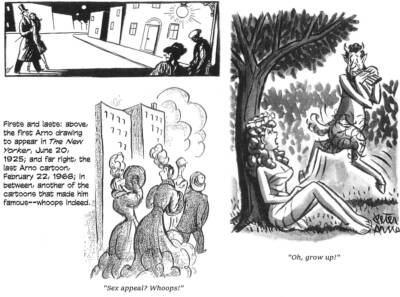 Writing the Introduction to 1979’s collection, Peter Arno, fellow cartoonist Charles Saxon reported that only a small group came to Arno’s funeral. “After the service, his daughter Pat showed those attending a fairly recent photograph of her father. Except for herself, Geraghty, and Arno’s devoted nurse-companion, no one had actually seen him for years.”
Writing the Introduction to 1979’s collection, Peter Arno, fellow cartoonist Charles Saxon reported that only a small group came to Arno’s funeral. “After the service, his daughter Pat showed those attending a fairly recent photograph of her father. Except for herself, Geraghty, and Arno’s devoted nurse-companion, no one had actually seen him for years.”
The New York Times printed Arno’s obituary on the front page, signifying perhaps that in his person and in his work, he had so typified a New Yorker as to be archetypal of the breed. And so he was.
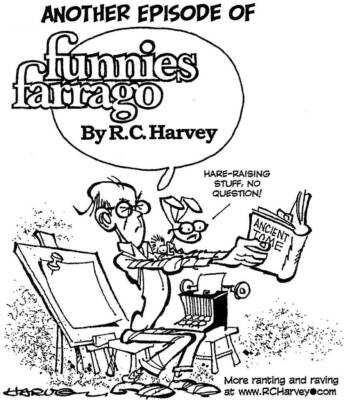 Bibliography. Information about Peter Arno’s life can be found in The New York Times’ obituary, February 23, 1968, in The Dictionary of American Biography, in Current Biography 1942, and in The World Encyclopedia of Cartoons (1980), edited by Maurice Horn. In addition to his cartooning, Arno wrote a modestly successful song, My Heart Is on My Sleeve, in the 1920s and a novel based upon his first cartoon characters, Whoops Dearie! (1927), and he co-authored a Broadway musical satire, Here Comes the Bride (1931). Several collections of his cartoons have been published: Peter Arno’s Parade (1929), Peter Arno’s Hullabaloo (1930), Peter Arno’s Circus (1930), Peter Arno’s Favorites (1931), Peter Arno’s Bride for a Night (1934), For Members Only (1935), Peter Arno’s Cartoon Revue with an introduction by Somerset Maugham (1941), Peter Arno’s Man in the Shower (1944), Peter Arno’s Pocket Book (1946), Peter Arno’s Sizzling Platter (1949), Peter Arno’s Ladies and Gentlemen which includes introductory matter by Arno in which he describes his methods and answers questions about his work (1951), and Peter Arno’s Hell of A Way To Run A Railroad (1956). Arno’s relationship with Harold Ross and his place in the history of The New Yorker is briefly discussed in Ross and the New Yorker (1951) by Dale Kramer, The Years with Ross (1959) by James Thurber, and Here at the New Yorker (1975) by Brendan Gill.
Bibliography. Information about Peter Arno’s life can be found in The New York Times’ obituary, February 23, 1968, in The Dictionary of American Biography, in Current Biography 1942, and in The World Encyclopedia of Cartoons (1980), edited by Maurice Horn. In addition to his cartooning, Arno wrote a modestly successful song, My Heart Is on My Sleeve, in the 1920s and a novel based upon his first cartoon characters, Whoops Dearie! (1927), and he co-authored a Broadway musical satire, Here Comes the Bride (1931). Several collections of his cartoons have been published: Peter Arno’s Parade (1929), Peter Arno’s Hullabaloo (1930), Peter Arno’s Circus (1930), Peter Arno’s Favorites (1931), Peter Arno’s Bride for a Night (1934), For Members Only (1935), Peter Arno’s Cartoon Revue with an introduction by Somerset Maugham (1941), Peter Arno’s Man in the Shower (1944), Peter Arno’s Pocket Book (1946), Peter Arno’s Sizzling Platter (1949), Peter Arno’s Ladies and Gentlemen which includes introductory matter by Arno in which he describes his methods and answers questions about his work (1951), and Peter Arno’s Hell of A Way To Run A Railroad (1956). Arno’s relationship with Harold Ross and his place in the history of The New Yorker is briefly discussed in Ross and the New Yorker (1951) by Dale Kramer, The Years with Ross (1959) by James Thurber, and Here at the New Yorker (1975) by Brendan Gill.
- Funnies Farrago Celebrates a Half Century of Doonesbury - June 1, 2022
- Who Really Invented the Comic Character ‘Archie’? - May 7, 2022
- Dick Wright Returns - April 5, 2022

